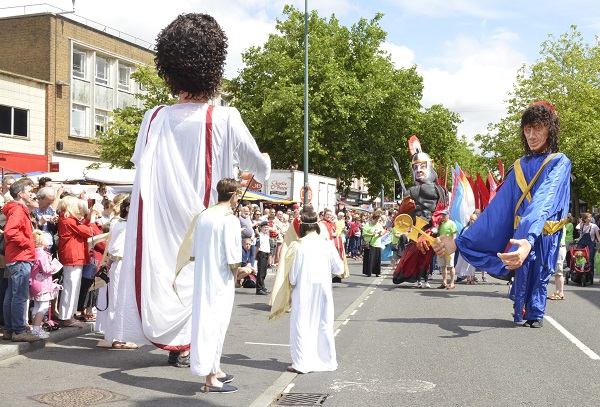As the Cathedral approaches one year to the opening of a new welcome centre and learning facilities as part of our Heritage Lottery funded project, work is underway to develop how we will communicate the remarkable story of Britain’s first saint to our visitors.
Plans are being finalised for a new timeline in the welcome centre, giving our visitors historical context before they step into the building. Films and interactive displays will tell the story of the living, working building. Audio visual projectors will be installed to illuminate in colour our magnificent set of medieval wall paintings; this technical innovation is the first of its kind in an English Cathedral and will recreate the original effect of the paintings. Visitors will see the paintings as pilgrims would have seen them centuries ago.
The story of Alban is a remarkable account of bravery and standing up for what you believe in. This is the story we want people to know and be inspired by when they visit. There will be many ways to learn the story of Britain’s first saint as you travel through the building – and what a story it is to tell.
Alban lived around the year 300 in the Roman city of Verulamium, in the valley below the present Cathedral. One day he gave shelter to a stranger, who turned out to be a Christian priest. At this time Roman citizens were still forbidden to become Christians, so Alban was taking a risk by welcoming the priest into his home.
Alban was so moved by the priest’s faith and courage that he asked to be become a Christian too. Before long the authorities came to arrest the fugitive priest. Alban, inspired by his new-found faith, enabled the priest to escape. The Roman soldiers arrested Alban and brought him before the city magistrate. Alban refused to sacrifice to the Roman gods, and declared: ‘I am Alban and I worship and adore the true and living God, who created all things’.

The magistrate ordered that Alban should receive the punishment that the escaped priest should have suffered. Alban was brought out of the town and up a hill to the site of execution. He is honoured as the first British saint and martyr, and his burial place on this hillside quickly became a place of pilgrimage. When Christians were finally permitted to worship freely they built a church here.
That first church was probably a simple structure over Alban’s grave, making this the oldest continuous site of Christian worship in Britain. In 429 a European bishop called Germanus recorded his visit to St Alban’s church – he is the first pilgrim for whom we have a name and a date. In the early eighth century the historian Bede told the story of St Alban and described ‘a beautiful church, worthy of his martyrdom’.
The Anglo-Saxon King Offa founded an abbey of monks here in 793. They followed rules for life set out by St Benedict, who had said they should welcome every stranger as though that person was Christ himself. People came on pilgrimage in large numbers to Alban’s shrine.

When the Normans arrived in England a new Abbot called Paul of Caen was appointed in 1077 – he built much of what you see today including the huge, strong tower. The church was enlarged several times by later generations. After the monks were sent away by Henry VIII in 1539, the townspeople bought the enormous building to use as their parish church. In 1877 it was chosen to become the cathedral and the spiritual home of the bishop for the new diocese of St Albans.
Alban’s welcome to a persecuted stranger was a powerful example of courage, compassion and hospitality. He is an inspiration to people of many faiths and none and his story is commemorated annually by the city as part of the Alban Pilgrimage. Every day pilgrims still visit his shrine and, in time, the surviving pieces of the historic shrine of Amphibalus, the priest who Alban saved, will be cleaned and re-built so that we can tell his story too.